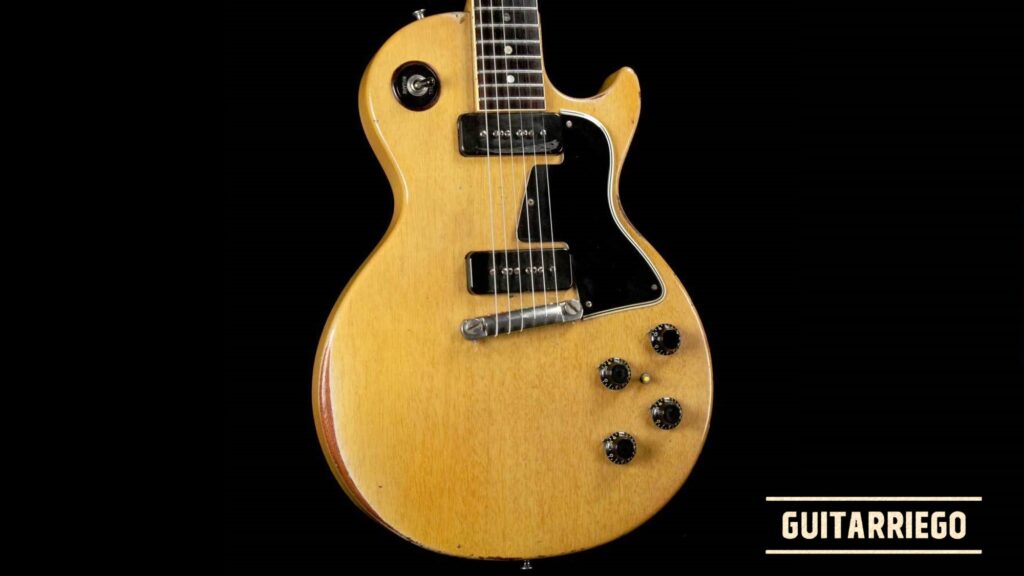TV Yellow: history and myths of a classic Gibson color

TV Yellow is a iconic color in the history of guitar maker Gibson, the finish used for Junior and Special Les Paul has a story of myths.
This is the first note in a series of articles related to classic colors, to vintage tones of classic guitars such as the Fiesta Red Fender Stratocaster, Fender Telecaster, the Gibson Les Paul, among others.
What is the TV Yellow color?
TV Yellow is a classic color and much loved in the world of guitars. It is instantly recognizable, but frustratingly very difficult to reproduce. It has a hue that varies from whitish or beige, to pale mustard yellow or even almost caramel. While it may appear solid or opaque at first glance, it is actually slightly translucent, which means that its appearance will also depend, to some extent, on the color, tone, and grain of the wood under it. This also means that it does not remain the same if it is applied on mahogany or maple.
It really is an interesting shade, to say the least, with a story covered in myths.
History of TV Yellow
To see its history, you have to go back to 1954, when Gibson launched the Les Paul Junior. The Junior model emerged as a cheaper and more accessible version of the Les Paul Goldtop.

Its first version was in a two-color Sunburst finish. But quickly, that same year, Gibson released the Les Paul TV model, essentially a Les Paul Junior finished in this peculiar yellow color, which would later be christened TV Yellow.
But where exactly did this finish come from and why the TV designation? There are two versions.
Trendy color used in TV cabinets
One version of the story explains that in the early days of television, televisions in the home were considered furniture, and their decorative wooden cabinets were finished in the same colors as other furniture.
One of the fashionable colors at that time was a yellowish color that the catalogs called “Limed Mahogany”, which would be a “Yellowish Mahogany”.

When introduced, the Les Paul TV was also described in Gibson’s catalogs as a Limed Mahogany finish. From which it can be deduced that it simply received the designation of “TV” because the finish in the same color as the TV cabinets. Later, in the guitar world, the “Limed Mahogany” was lost and the color name eventually became “TV Yellow” simply because of its close association with the Les Paul TV model.
The myth of TV Yellow
However, there is another story that is much more fun. If you’ve ever watched black-and-white television images from the 1940s and 1950s, you’ve probably noticed that white objects often appear exaggeratedly bright, haloed, or fuzzy.
This effect was due to several factors. For one thing, most early television shows were filmed live and required very bright, almost daytime studio lighting levels. To exacerbate the situation, the first video cameras to film live action were tube or vacuum tubes, and those tubes or tubes did not have the dynamic range necessary to handle high-brightness areas. The resulting bright spots in the video signal are analogous to the heat or “sag” exhibited by tube audio amplifiers when pushed beyond their range.

For all these reasons, wearing white clothing or wearing pure white accessories was discouraged in a live TV session.
So this version explains that Les Paul, the legendary inventor, guitarist, and TV star suggested a wheat-colored guitar finish. The color would appear white on live TV broadcasts, but because it wasn’t actually white, it wouldn’t overwhelm cameras with bright lights. The “yellow” finish was adopted by Gibson, and is sometimes referred to as TV White. Guitars made in this color are very rare. The color was later modified by adding yellow, and the Les Paul TV model was released.
Analysis of the history of TV Yellow
Which of these versions of the story is true? The answer seems obvious and is almost a matter of common sense. Gibson probably only got paint that was already readily available and in widespread use like that used on TV cabinets of the time.

Also, it doesn’t make much sense for Gibson to develop a finish or color to aid professional musicians during live TV sessions that is only used on a cheap and accessible studio guitar.
But regardless of what you think or want to believe, fortunately, both versions of the story are not mutually exclusive.
What do you think?
For more information, head over to Gibson.
Related Articles: Ted McCarty and Gibson’s Golden Age.
You can share opinions or also chat about this and more with other musicians in our comments section.






